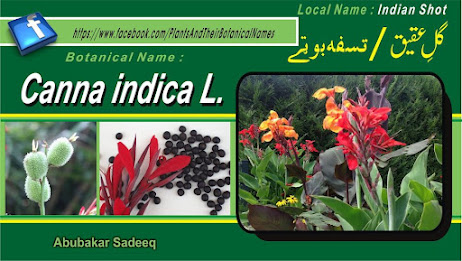Canna indica L. (Ornamental)
Family Name: Cannaceae
Synonyms: Canna limbata, Canna lutea, Canna compacta
Common Name: Indian Shot, African Arrowroot, Pisang Sebiak, Bunga Tasbih, Daun Tasbih, 美人蕉، گل عقیق،تسفہ بوٹے،تسبیح
Canna indica L., normally called Indian shot or absolutely canna, is a perennial flowering plant species belonging to the Cannaceae circle of relatives. It is native to tropical and subtropical regions of the Americas however has been widely cultivated and naturalized in lots of parts of the arena.
Right here are a few key traits of Canna indica:
1. Look: Canna indica is a herbaceous plant that generally grows to a peak of one to two meters (three to 6 feet). It has huge, attractive, paddle-fashioned leaves which might be normally inexperienced or variegated with distinct styles. The leaves are arranged alternately along the stems.
2. Flora: The plant produces putting and colorful flora which is one of its fundamental attractions. The vegetation is borne in terminal racemes or panicles, and they arrive in a diffusion of colors, such as sunglasses of purple, orange, yellow, and purple. Some cultivars might also have bi-colored or speckled flora.
Three. Rhizomatous boom: Canna indica grows from underground rhizomes, which are fleshy, horizontal stems that store vitamins and water. These rhizomes allow the plant to live to tell the tale of destructive conditions and resprout after iciness dormancy.
4. Cultivation: Canna indica is often grown as a decorative plant in gardens and landscapes because of its colorful flora and appealing foliage. It thrives in complete solar but can tolerate partial color. It prefers nicely-draining soil and can be grown in both wet and dry situations, making it appropriate for diverse garden settings.
Five. Geographic Distribution: As referred to in advance, Canna indica is local to the Americas, mainly regions in vital and South of the united states, which includes parts of the Caribbean. However, it has been extensively cultivated in different tropical and subtropical areas, which include Asia, Africa, and Australia.
6. Conventional makes use of: some indigenous groups inside the native range of Canna indica have applied various parts of the plant for traditional remedies and different purposes. The rhizomes had been used for their medicinal properties, inclusive of remedies for digestive problems, irritation, and wounds.
It is essential to note that at the same time as Canna indica isn't always taken into consideration enormously toxic, the plant includes alkaloids which could motivate slight pores and skin infection or gastrointestinal soreness if ingested in massive quantities. As with any plant, caution ought to be exercised, particularly if there are pets or small children around.
On average, Canna indica is valued for its striking appearance and resilience, making it a famous desire for decorative gardening in appropriate climates.
for more plant ids https://web.facebook.com/PlantsAndTheirBotanicalNames/
for more plant ids https://web.facebook.com/PlantsAndTheirBotanicalNames/





No comments